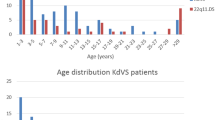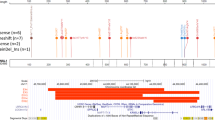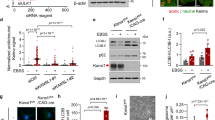Abstract
The Koolen-de Vries syndrome (KdVS; OMIM #610443), also known as the 17q21.31 microdeletion syndrome, is a clinically heterogeneous disorder characterised by (neonatal) hypotonia, developmental delay, moderate intellectual disability, and characteristic facial dysmorphism. Expressive language development is particularly impaired compared with receptive language or motor skills. Other frequently reported features include social and friendly behaviour, epilepsy, musculoskeletal anomalies, congenital heart defects, urogenital malformations, and ectodermal anomalies. The syndrome is caused by a truncating variant in the KAT8 regulatory NSL complex unit 1 (KANSL1) gene or by a 17q21.31 microdeletion encompassing KANSL1. Herein we describe a novel cohort of 45 individuals with KdVS of whom 33 have a 17q21.31 microdeletion and 12 a single-nucleotide variant (SNV) in KANSL1 (19 males, 26 females; age range 7 months to 50 years). We provide guidance about the potential pitfalls in the laboratory testing and emphasise the challenges of KANSL1 variant calling and DNA copy number analysis in the complex 17q21.31 region. Moreover, we present detailed phenotypic information, including neuropsychological features, that contribute to the broad phenotypic spectrum of the syndrome. Comparison of the phenotype of both the microdeletion and SNV patients does not show differences of clinical importance, stressing that haploinsufficiency of KANSL1 is sufficient to cause the full KdVS phenotype.
Similar content being viewed by others
Log in or create a free account to read this content
Gain free access to this article, as well as selected content from this journal and more on nature.com
or
References
Koolen DA, Vissers LE, Pfundt R et al: A new chromosome 17q21.31 microdeletion syndrome associated with a common inversion polymorphism. Nat Genet 2006; 38: 999–1001.
Shaw-Smith C, Pittman AM, Willatt L et al: Microdeletion encompassing MAPT at chromosome 17q21.3 is associated with developmental delay and learning disability. Nat Genet 2006; 38: 1032–1037.
Sharp AJ, Hansen S, Selzer RR et al: Discovery of previously unidentified genomic disorders from the duplication architecture of the human genome. Nat Genet 2006; 38: 1038–1042.
Koolen DA, Kramer JM, Neveling K et al: Mutations in the chromatin modifier gene KANSL1 cause the 17q21.31 microdeletion syndrome. Nat Genet 2012; 44: 639–641.
Zollino M, Orteschi D, Murdolo M et al: Mutations in KANSL1 cause the 17q21.31 microdeletion syndrome phenotype. Nat Genet 2012; 44: 636–638.
Dias J, Van Nguyen N, Georgiev P et al: Structural analysis of the KANSL1/WDR5/KANSL2 complex reveals that WDR5 is required for efficient assembly and chromatin targeting of the NSL complex. Genes Dev 2014; 28: 929–942.
Cai Y, Jin J, Swanson SK et al: Subunit composition and substrate specificity of a MOF-containing histone acetyltransferase distinct from the male-specific lethal (MSL) complex. J Biol Chem 2010; 285: 4268–4272.
Raja SJ, Charapitsa I, Conrad T et al: The nonspecific lethal complex is a transcriptional regulator in Drosophila. Mol Cell 2010; 38: 827–841.
Mendjan S, Taipale M, Kind J et al: Nuclear pore components are involved in the transcriptional regulation of dosage compensation in Drosophila. Mol Cell 2006; 21: 811–823.
Steinberg KM, Antonacci F, Sudmant PH et al: Structural diversity and African origin of the 17q21.31 inversion polymorphism. Nat Genet 2012; 44: 872–880.
Boettger LM, Handsaker RE, Zody MC, McCarroll SA : Structural haplotypes and recent evolution of the human 17q21.31 region. Nat Genet 2012; 44: 881–885.
Stefansson H, Helgason A, Thorleifsson G et al: A common inversion under selection in Europeans. Nat Genet 2005; 37: 129–137.
Koolen DA, Sharp AJ, Hurst JA et al: Clinical and molecular delineation of the 17q21.31 microdeletion syndrome. J Med Genet 2008; 45: 710–720.
Zody MC, Jiang Z, Fung HC et al: Evolutionary toggling of the MAPT 17q21.31 inversion region. Nat Genet 2008; 40: 1076–1083.
Itsara A, Vissers LE, Steinberg KM et al: Resolving the breakpoints of the 17q21.31 microdeletion syndrome with next-generation sequencing. Am J Hum Genet 2012; 90: 599–613.
Digilio MC, Bernardini L, Capolino R et al: Hypopigmented skin patches in 17q21.31 microdeletion syndrome: expanding the spectrum of cutaneous findings. Clin Dysmorphol 2014; 23: 32–34.
Dornelles-Wawruk H, Pic-Taylor A, Rosenberg C et al: Complex phenotype associated with 17q21.31 microdeletion. Mol Syndromol 2013; 4: 297–301.
Dubourg C, Sanlaville D, Doco-Fenzy M et al: Clinical and molecular characterization of 17q21.31 microdeletion syndrome in 14 French patients with mental retardation. Eur J Med Genet 2011; 54: 144–151.
El Chehadeh-Djebbar S, Callier P, Masurel-Paulet A et al: 17q21.31 microdeletion in a patient with pituitary stalk interruption syndrome. Eur J Med Genet 2011; 54: 369–373.
Koolen DA, Dupont J, de Leeuw N et al: Two families with sibling recurrence of the 17q21.31 microdeletion syndrome due to low-grade mosaicism. Eur J Hum Genet 2012; 20: 729–733.
Sharkey FH, Morrison N, Murray R et al: 17q21.31 microdeletion syndrome: further expanding the clinical phenotype. Cytogenet Genome Res 2009; 127: 61–66.
Tan TY, Aftimos S, Worgan L et al: Phenotypic expansion and further characterisation of the 17q21.31 microdeletion syndrome. J Med Genet 2009; 46: 480–489.
Terrone G, D'Amico A, Imperati F et al: A further contribution to the delineation of the 17q21.31 microdeletion syndrome: central nervous involvement in two Italian patients. Eur J Med Genet 2012; 55: 466–471.
Vlckova M, Hancarova M, Drabova J et al: Monozygotic twins with 17q21.31 microdeletion syndrome. Twin Res Hum Genet 2014; 17: 405–410.
Wray CD : 17q21.31 microdeletion associated with infantile spasms. Eur J Med Genet 2013; 56: 59–61.
Wright EB, Donnai D, Johnson D, Clayton-Smith J : Cutaneous features in 17q21.31 deletion syndrome: a differential diagnosis for cardio-facio-cutaneous syndrome. Clin Dysmorphol 2011; 20: 15–20.
Varela MC, Krepischi-Santos AC, Paz JA et al: A 17q21.31 microdeletion encompassing the MAPT gene in a mentally impaired patient. Cytogenet Gen Res 2006; 114: 89–92.
Cooper GM, Coe BP, Girirajan S et al: A copy number variation morbidity map of developmental delay. Nat Genet 2011; 43: 838–846.
Jaillard S, Drunat S, Bendavid C et al: Identification of gene copy number variations in patients with mental retardation using array-CGH: novel syndromes in a large French series. Eur J Med Genet 2010; 53: 66–75.
Kitsiou-Tzeli S, Frysira H, Giannikou K et al: Microdeletion and microduplication 17q21.31 plus an additional CNV, in patients with intellectual disability, identified by array-CGH. Gene 2012; 492: 319–324.
Maley AM, Spraker MK, de Vries BB, Koolen DA : Vitiligo in the Koolen-de Vries or 17q21.31 microdeletion syndrome. Clin Dysmorphol 2015; 24: 86–87.
Barone C, Novelli A, Capalbo A et al: An additional clinical sign of 17q21.31 microdeletion syndrome: preaxial polydactyly of hands with broad thumbs. Am J Med Genet Part A 2015; 167: 1671–1673.
Wright CF, Fitzgerald TW, Jones WD et al: Genetic diagnosis of developmental disorders in the DDD study: a scalable analysis of genome-wide research data. Lancet 2014; 385: 1305–1314.
Coe BP, Witherspoon K, Rosenfeld JA et al: Refining analyses of copy number variation identifies specific genes associated with developmental delay. Nat Genet 2014; 46: 1063–1071.
Fokkema IF, Taschner PE, Schaafsma GC, Celli J, Laros JF, den Dunnen JT : LOVD v.2.0: the next generation in gene variant databases. Hum Mutat 2011; 32: 557–563.
1000 Genomes Project Consortium 1000 Genomes Project Consortium, Abecasis GR, Auton A, Brooks LD et al: An integrated map of genetic variation from 1,092 human genomes. Nature 2012; 491: 56–65.
Vulto-van Silfhout AT, Hehir-Kwa JY, van Bon BW et al: Clinical significance of de novo and inherited copy-number variation. Hum Mutat 2013; 34: 1679–1687.
Acknowledgements
We thank the individuals and their parents for participation in this study. We are especially thankful to the board members of the foundation Supporting Families with Koolen-de Vries Syndrome (http://www.supportingkdvs.com/). We also thank T Dijkhuizen for sharing microarray data with us and L van Diepen, JM Geelen, WM Wissink-Lindhout, and KJ Pijnenburg-Kleizen for data management. The study was financially supported by the Netherlands Organisation for Health Research and Development (ZON-MW grant 917-86-319 and 912-12-109 to BBAdV) and by the Italian Ministry of Health and ‘5 per mille’ funding (to PF, CB, EA, CR). JG was supported by Australian NHMRC grant 628952 and Research Fellowship 1041920. The DDD Study is funded by HICF-1009-003 and WT098051. This study uses data from the 1000 Genomes project phase 3 data release.
Author information
Authors and Affiliations
Consortia
Corresponding author
Ethics declarations
Competing interests
The authors declare no conflict of interest.
Additional information
Supplementary Information accompanies this paper on European Journal of Human Genetics website
Rights and permissions
About this article
Cite this article
Koolen, D., Pfundt, R., Linda, K. et al. The Koolen-de Vries syndrome: a phenotypic comparison of patients with a 17q21.31 microdeletion versus a KANSL1 sequence variant. Eur J Hum Genet 24, 652–659 (2016). https://doi.org/10.1038/ejhg.2015.178
Received:
Revised:
Accepted:
Published:
Issue date:
DOI: https://doi.org/10.1038/ejhg.2015.178
This article is cited by
-
Anesthesia management for a child with the Koolen-de Vries syndrome: a case report
BMC Anesthesiology (2024)
-
A new blood DNA methylation signature for Koolen-de Vries syndrome: Classification of missense KANSL1 variants and comparison to fibroblast cells
European Journal of Human Genetics (2024)
-
Expanding the speech and language phenotype in Koolen-de Vries syndrome: late onset and periodic stuttering a novel feature
European Journal of Human Genetics (2023)
-
COX17 acetylation via MOF–KANSL complex promotes mitochondrial integrity and function
Nature Metabolism (2023)
-
GenIDA: an international participatory database to gain knowledge on health issues related to genetic forms of neurodevelopmental disorders
Journal of Neural Transmission (2023)



